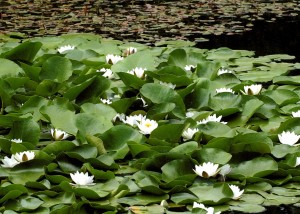 White water-lilies cannot really be confused with any other aquatic plant as its round leaves are between ten and thirty centimetres across. They are smooth and shiny and are dark green above and, normally, reddish wine colour below. The white flowers, the largest in Britain, are at their best in July but still show well in August. The whole plant is impressive by any standards as apart from the size of the leaves the stem can be three metres long from its rhizome in the bed of the loch to the floating leaves. This is the commonest and most widespread water-lily of the three species that occur in Britain. It has a curious distribution in the Highlands as it occurs in most parts of the Mainland and the Western Isles. Whilst it occurs in Shetland for some unknown reason it does not occur in Orkney.
White water-lilies cannot really be confused with any other aquatic plant as its round leaves are between ten and thirty centimetres across. They are smooth and shiny and are dark green above and, normally, reddish wine colour below. The white flowers, the largest in Britain, are at their best in July but still show well in August. The whole plant is impressive by any standards as apart from the size of the leaves the stem can be three metres long from its rhizome in the bed of the loch to the floating leaves. This is the commonest and most widespread water-lily of the three species that occur in Britain. It has a curious distribution in the Highlands as it occurs in most parts of the Mainland and the Western Isles. Whilst it occurs in Shetland for some unknown reason it does not occur in Orkney.
With such an impressive plant as white water-lilies it is not surprising that it has been used as a medicine, for culinary use and in the Harris Tweed industry. In the latter the rhizomes were used to form a black or dark brown dye. To release the dye the rhizomes were boiled for a long time with alum. Harvesting the rhizomes can be a dangerous practice as they are very firmly attached to the bottom on lochs and lochans. They were normally gathered when the water levels were low because of the great depth of water in which the water- lilies grow. At one time small rafts were used to harvest the rhizomes as it took some strength to wrench them from the bottom.
In the world of medicine, poultices were used for various ailments. In the records of Inveraray Castle in the 18th century the poultices were made from white water-lily rhizomes boiled in vinegar. The plants, leaves, stems and rhizomes were used for external and internal diseases. In the culinary world the rhizomes can be eaten when they are several years old and the inner part can be boiled but may be sharp to the taste. The seed can be ground to a flour and used as a thickener for soups and stews or can be roasted and used as a coffee substitute. Beware legislation as you can only use water-lilies for this purpose if you are the owner or have the owners permission. The photograph was taken at one of the “kettle” holes, formed by melting ice at the last glaciation, near Muir of Ord. It shows the large leaves and flowers and there is a bed of floating broad leaved pondweed in the background.
The yellow water lily is almost restricted to the south west of the Highlands and its leaves, oval and up to 40 centimetres long are the largest of any British aquatic plant. The third species, the least water-lily, is the rarest lily in Britain and is almost confined to Scotland. There are a few sites in the Highlands including one on a hill loch in Glen Strathfarrar. The white water-lily, despite being common and impressive, does not seem to have been used by any Clan as a plant badge perhaps because it is difficult to get hold of without a boat. It could also be that the sheer size of the leaves would make it impractical to use. Local names for the white water-lily include water bells and water blobs whilst Scots names include cambie leaf. The Gaelic name of the white water-lily is Duilleag-bhaite Bhan which means “white drowned leaf”. The name for the yellow water-lily is Duilleag-bhaite Bhuidhe which means, not surprisingly, “yellow drowned leaf”.
